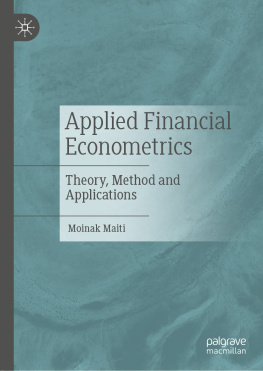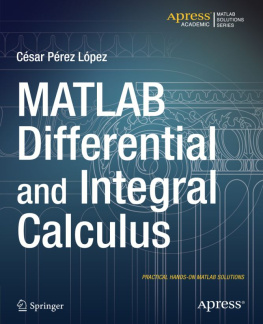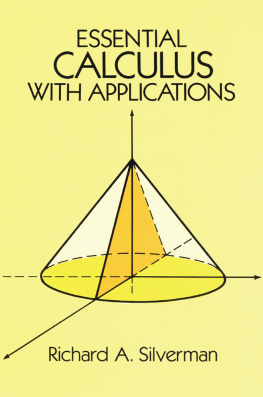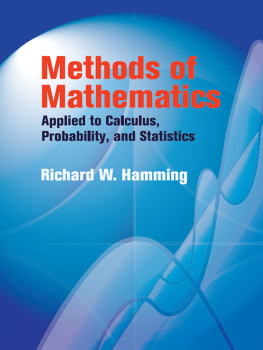Jan R. Magnus - Matrix Differential Calculus with Applications in Statistics and Econometrics
Here you can read online Jan R. Magnus - Matrix Differential Calculus with Applications in Statistics and Econometrics full text of the book (entire story) in english for free. Download pdf and epub, get meaning, cover and reviews about this ebook. year: 2019, publisher: Wiley, genre: Children. Description of the work, (preface) as well as reviews are available. Best literature library LitArk.com created for fans of good reading and offers a wide selection of genres:
Romance novel
Science fiction
Adventure
Detective
Science
History
Home and family
Prose
Art
Politics
Computer
Non-fiction
Religion
Business
Children
Humor
Choose a favorite category and find really read worthwhile books. Enjoy immersion in the world of imagination, feel the emotions of the characters or learn something new for yourself, make an fascinating discovery.

- Book:Matrix Differential Calculus with Applications in Statistics and Econometrics
- Author:
- Publisher:Wiley
- Genre:
- Year:2019
- Rating:4 / 5
- Favourites:Add to favourites
- Your mark:
- 80
- 1
- 2
- 3
- 4
- 5
Matrix Differential Calculus with Applications in Statistics and Econometrics: summary, description and annotation
We offer to read an annotation, description, summary or preface (depends on what the author of the book "Matrix Differential Calculus with Applications in Statistics and Econometrics" wrote himself). If you haven't found the necessary information about the book — write in the comments, we will try to find it.
Jan R. Magnus: author's other books
Who wrote Matrix Differential Calculus with Applications in Statistics and Econometrics? Find out the surname, the name of the author of the book and a list of all author's works by series.
Matrix Differential Calculus with Applications in Statistics and Econometrics — read online for free the complete book (whole text) full work
Below is the text of the book, divided by pages. System saving the place of the last page read, allows you to conveniently read the book "Matrix Differential Calculus with Applications in Statistics and Econometrics" online for free, without having to search again every time where you left off. Put a bookmark, and you can go to the page where you finished reading at any time.
Font size:
Interval:
Bookmark:
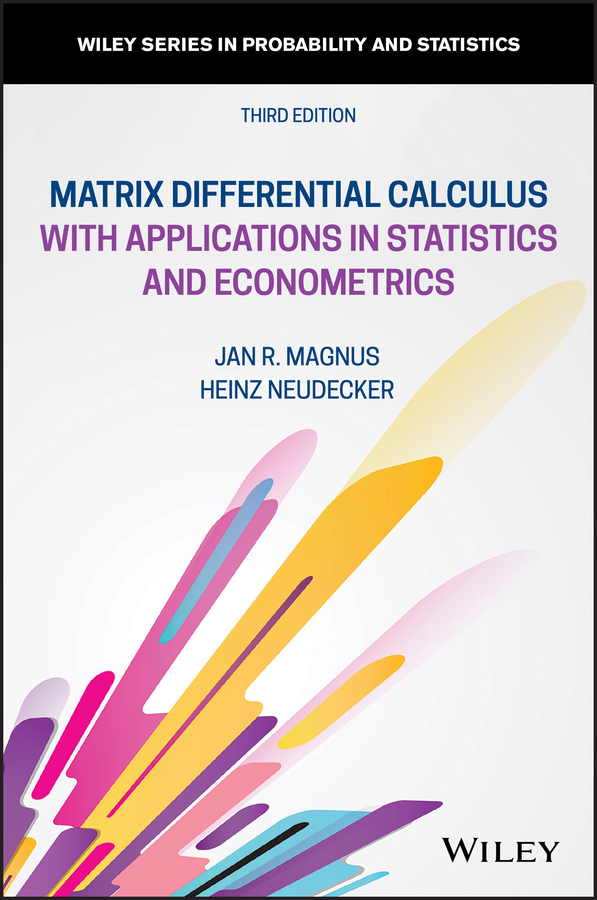
- Chapter 9
- Chapter 10
- Chapter 4
- Chapter 5
- Chapter 7
- Chapter 8
- Chapter 11
WILEY SERIES IN PROBABILITY AND STATISTICS
Established by Walter E. Shewhart and Samuel S. Wilks
Editors: David J. Balding, Noel A. C. Cressie, Garrett M. Fitzmaurice, Geof H. Givens, Harvey Goldstein, Geert Molenberghs, David W. Scott, Adrian F. M. Smith, and Ruey S. Tsay
Editors Emeriti: J. Stuart Hunter, Iain M. Johnstone, Joseph B. Kadane, and Jozef L. Teugels
The Wiley Series in Probability and Statistics is well established and authoritative. It covers many topics of current research interest in both pure and applied statistics and probability theory. Written by leading statisticians and institutions, the titles span both stateoftheart developments in the field and classical methods.
Reflecting the wide range of current research in statistics, the series encompasses applied, methodological, and theoretical statistics, ranging from applications and new techniques made possible by advances in computerized practice to rigorous treatment of theoretical approaches. This series provides essential and invaluable reading for all statisticians, whether in academia, industry, government, or research.
A complete list of the titles in this series can be found at http://www.wiley.com/go/wsps
Third Edition
Jan R. Magnus
Department of Econometrics and Operations Research
Vrije Universiteit Amsterdam, The Netherlands
and
Heinz Neudeckery
Amsterdam School of Economics
University of Amsterdam, The Netherlands

Copyright
This edition first published 2019
2019 John Wiley & Sons Ltd
Edition History
John Wiley & Sons (1e, 1988) and John Wiley & Sons (2e, 1999)
All rights reserved. No part of this publication may be reproduced, stored in a retrieval system, or transmitted, in any form or by any means, electronic, mechanical, photocopying, recording or otherwise, except as permitted by law. Advice on how to obtain permission to reuse material from this title is available at http://www.wiley.com/go/permissions.
The right of Jan R. Magnus and Heinz Neudecker to be identified as the authors of this work has been asserted in accordance with law.
Registered Offices
John Wiley & Sons, Inc., 111 River Street, Hoboken, NJ 07030, USA
John Wiley & Sons Ltd, The Atrium, Southern Gate, Chichester, West Sussex, PO19 8SQ, UK
Editorial Office
9600 Garsington Road, Oxford, OX4 2DQ, UK
For details of our global editorial offices, customer services, and more information about Wiley products visit us at www.wiley.com.
Wiley also publishes its books in a variety of electronic formats and by printondemand. Some content that appears in standard print versions of this book may not be available in other formats.
Limit of Liability/Disclaimer of Warranty
While the publisher and authors have used their best efforts in preparing this work, they make no representations or warranties with respect to the accuracy or completeness of the contents of this work and specifically disclaim all warranties, including without limitation any implied warranties of merchantability or fitness for a particular purpose. No warranty may be created or extended by sales representatives, written sales materials or promotional statements for this work. The fact that an organization, website, or product is referred to in this work as a citation and/or potential source of further information does not mean that the publisher and authors endorse the information or services the organization, website, or product may provide or recommendations it may make. This work is sold with the understanding that the publisher is not engaged in rendering professional services. The advice and strategies contained herein may not be suitable for your situation. You should consult with a specialist where appropriate. Further, readers should be aware that websites listed in this work may have changed or disappeared between when this work was written and when it is read. Neither the publisher nor authors shall be liable for any loss of profit or any other commercial damages, including but not limited to special, incidental, consequential, or other damages.
Library of Congress CataloginginPublication Data applied for
ISBN: 9781119541202
Cover design by Wiley
Cover image: phochi/Shutterstock
Preface to the first edition
There has been a longfelt need for a book that gives a selfcontained and unified treatment of matrix differential calculus, specifically written for econometricians and statisticians. The present book is meant to satisfy this need. It can serve as a textbook for advanced undergraduates and postgraduates in econometrics and as a reference book for practicing econometricians. Mathematical statisticians and psychometricians may also find something to their liking in the book.
When used as a textbook, it can provide a fullsemester course. Reasonable proficiency in basic matrix theory is assumed, especially with the use of partitioned matrices. The basics of matrix algebra, as deemed necessary for a proper understanding of the main subject of the book, are summarized in Part One, the first of the books six parts. The book also contains the essentials of multivariable calculus but geared to and often phrased in terms of differentials.
The sequence in which the chapters are being read is not of great consequence. It is fully conceivable that practitioners start with Part Three (Differentials: the practice) and, dependent on their predilections, carry on to Parts Five or Six, which deal with applications. Those who want a full understanding of the underlying theory should read the whole book, although even then they could go through the necessary matrix algebra only when the specific need arises.
Matrix differential calculus as presented in this book is based on differentials, and this sets the book apart from other books in this area. The approach via differentials is, in our opinion, superior to any other existing approach. Our principal idea is that differentials are more congenial to multivariable functions as they crop up in econometrics, mathematical statistics, or psychometrics than derivatives, although from a theoretical point of view the two concepts are equivalent.
The book falls into six parts. Part One deals with matrix algebra. It lists, and also often proves, items like the Schur, Jordan, and singularvalue decompositions; concepts like the Hadamard and Kronecker products; the vec operator; the commutation and duplication matrices; and the MoorePenrose inverse. Results on bordered matrices (and their determinants) and (linearly restricted) quadratic forms are also presented here.
Part Two, which forms the theoretical heart of the book, is entirely devoted to a thorough treatment of the theory of differentials, and presents the essentials of calculus but geared to and phrased in terms of differentials. First and second differentials are defined, identification rules for Jacobian and Hessian matrices are given, and chain rules derived. A separate chapter on the theory of (constrained) optimization in terms of differentials concludes this part.
Next pageFont size:
Interval:
Bookmark:
Similar books «Matrix Differential Calculus with Applications in Statistics and Econometrics»
Look at similar books to Matrix Differential Calculus with Applications in Statistics and Econometrics. We have selected literature similar in name and meaning in the hope of providing readers with more options to find new, interesting, not yet read works.
Discussion, reviews of the book Matrix Differential Calculus with Applications in Statistics and Econometrics and just readers' own opinions. Leave your comments, write what you think about the work, its meaning or the main characters. Specify what exactly you liked and what you didn't like, and why you think so.

